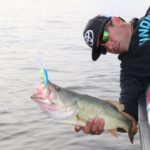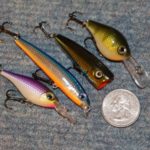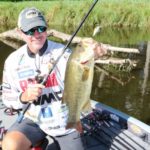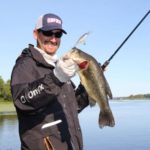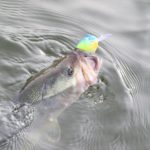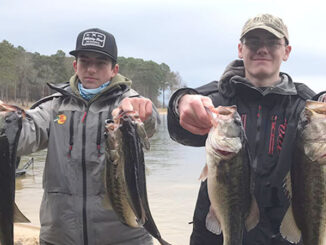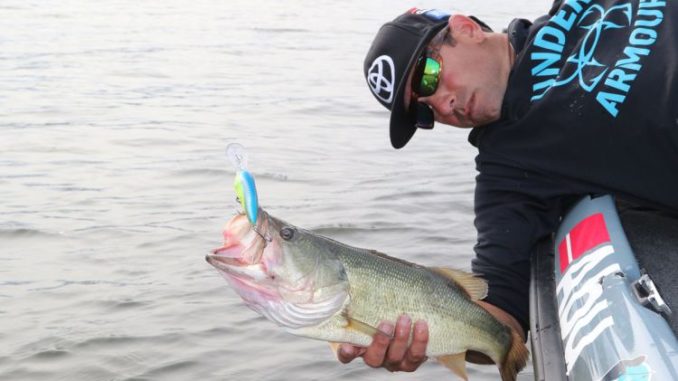
Natural wood crankbaits should definitely have a place in your lure arsenal. Keep these tips in mind to boat more bass this fall.
Bassmaster Elite Series pro Ott DeFoe is a product of his environment, and a particular aspect of those positive influences from his East Tennessee youth prove advantageous across southern waters.
We’re talking about balsa crankbaits — a love affair with which DeFoe was early smitten, and one he gladly shares with Louisiana anglers.
“I’ve always be a tinkerer with fishing stuff and I always liked working with wood; so growing up in East Tennessee, which has always been a hotbed of homemade balsa crankbaits, I started making my own baits,” DeFoe said. “I started doing it because, when I first started out, I didn’t want to be paying $12-$15 for a bait.
“But I began to see the success that guys had using them, and I heard how everybody’s was a little different. That’s why I wanted to make my own. One of the guys I used to fish with, his dad was into making balsa baits and he was nice enough to show me the ropes.”
Cool story, but DeFoe still trusts many of his professional fishing scenarios to balsa baits — both from the Rapala family and some of his tried-and-true personal creations. So, what’s the attraction? Well, there’s a handful of key points that make these natural wood crankbaits worthy of a significant role in your game plan.
Uniquely you
Without the machinery necessary for creating round body crankbaits, DeFoe stuck to the flat-sided baits he could craft with a router and hand tools. Today, his crankbait arsenal includes a variety of shapes and sizes, but the one thing they all have in common is their inherent difference.
“For me, the number one attraction for balsa baits is that every single one is a little different,” DeFoe said. “With a company like Rapala, their baits are as uniform as balsa can possibly be. They want every bait to run true, but balsa is a natural product; it’s not like plastic where you can completely control the density, hardness and everything.
“You’re going to get pieces of wood that are a touch heavier or a touch lighter and every one of those subtle differences makes every bait unique. Also, balsa baits aren’t fully machine made; they have to be touched by hand at some point, so that allows for little differences in every one of them.”
As DeFoe notes, while some may consider this nonconformity a drawback, he actually sees it as an advantage. For him, it’s the confidence of knowing that a particular wood grain is only in a single bait.
As DeFoe notes, some balsa baits are just unbelievable fish catchers and some are just run-of-the-mill. Because of this, it’s a good idea to test different baits of the same design to identify the one that best fits your need.
“If you can keep your colors down to four or five, get two of each bait you use,” DeFoe said. “Then you have a couple options of each color to see if one has slightly more hunt to it, or if one just feels a little better than the other one.”
Hope floats
One thing all balsa baits have in common is their superior buoyancy. The wood’s light density means it floats better than baits made fully of synthetic materials; and that defines one of the most fundamental balsa attractions.
Defoe knows that balsa’s natural buoyancy means dramatic deflections with more upward ascension for round body and squarebill crankbaits. Any fish attracted to the bait’s impact sound is likely to respond more aggressively when it appears that their prey is making a run for it.
Adding another important point, FLW Tour pro Wesley Strader said seasonal water dynamics won’t hinder his balsa baits. Unlike molded plastics, the wooden lures hold their own against winter’s chill.
“In the winter and early spring, the water is denser,” Strader said. “With a balsa bait, it deflects easier because of its buoyancy, whereas a plastic is really affected by the (water density). The colder the water is, the more delayed the response a plastic bait has, whereas with balsa, it’s instantaneous.”
For more perspective, we turn to Cliff Pace, the Elite pro from Mississippi and 2013 Bassmaster Classic champion who has been producing his handmade/hand-painted Black Label balsa baits for a few years now. One of his pet peeves with many of the flat-sided crankbaits of winter popularity is casting difficulty.
“We’ve all been there; you get on a good crankbait bite, the wind starts blowing and it becomes very difficult to make an accurate cast,” Pace said.
His solution further extols the balsa benefit. Pace weights his 2 ¾-inch Slim Series bait to 3/8-ounce; a design decision that gains valuable casting distance without destroying the bait’s buoyancy
“With balsa, you can build a bait (to specific weight) and it’s still going to be more buoyant than a plastic bait (of equal weight),” Pace said. “That allows you to have a (bait) that’s heavy enough to make super-accurate casts with.”
Subdued shiver
While he trusts balsa’s year-round appeal, DeFoe points to the lethargy of winter and summer’s extreme temperatures as prime times for balsa to shine. Reason being, a balsa bait produces a tight, subtle shimmer that mimics the lethargic wiggle of cold-season shad.
“In winter, my favorite balsa baits are flat side baits,” Pace said. “They typically don’t rise fast, but that tight, subtle action will trigger bites in cold water when other crankbaits will not.”
As DeFoe explains, round body and squarebill balsa crankbaits ratchet up the wiggle; but those skinny models like the ones he used to make are the ticket when fish are looking for slow-moving, easy meals.
When it’s right
With the exception of deep cranking there’s not many wrong times for balsa baits; but certain scenarios definitely showcase their strengths.
Pressured fisheries: Lots of boats on the lake means the fish see the same stuff repeatedly. Send in the balsa baits and their unique looks will outshine the overdone mass-produced plastics.
Bumping about: Elite pro Bill Lowen’s a big fan of balsa squarebills; so much so, he likens them to “little baby dump trucks” that’ll boldly rumble into cover and rumble right back out. Here, he said, the soft wood’s buoyancy allows the lure to float through cover; unlike plastic lures which don’t rise up and, therefore run a greater risk of snagging.
“That’s important because you can throw them into places most guys aren’t going to throw a treble hook bait,” Lowen said.
Into the zone: Superior buoyancy also affords DeFoe the ability to mimic a wayward baitfish.
“If you reel a balsa bait down into the V of a log, you can stop; and because the bait has so much buoyancy, it can back right out of that situation and you can stop reeling again,” he said. “It looks like something disoriented. You typically don’t see shad swimming along and running right into trees, unless they’re spawning, so it’s a little unnatural and the fish are more likely to key in on that and potentially see it as an easier target.”
Considerations
Protect the tool: “You have to take care of your balsa baits,” Pace said. “You can’t leave them in the floor of your boat and step all over them. It’s physically impossible to build a balsa bait that’s as durable as a plastic bait, so you can’t smack them on the water to clean them.”
The hunter: We refer to a crankbait’s erratic side-to-side movement as “hunting.” Sometimes, you want a lot; but other times, not so much. DeFoe explains.
“I always want a little bit of that motion, but the times when I want that to be very noticeable is in a shallow wood scenario,” he said. “When I’m bouncing the bait off wood, I want it to wander a little bit more; I want an exaggerated hunt of about 3-4 inches. Any more than that and you’re running on the limits of blowing out.
Also, with a bait that runs no more than 3-4 feet, hunting isn’t going to drastically affect the running depth. If you’re throwing a bait that’s made to run 8-12 feet deep and it’s hunting like crazy, you’re not going to achieve the depth you’re trying to achieve because it’s wandering off side to side.”
Step on the gas: And take note of DeFoe’s advice, which may seem to fly in the face of common balsa beliefs. In his view, there’s a time and a place for everything — and sometimes you gotta feel the need for speed.
“In cold water, a lot of times, you want to fish the bait really slow; but once that water hits the mid-50s and up, you can fish the bait a lot faster,” DeFoe said. “If you’re getting short strikes or fish are just pulling off, more times than not, the simplest fix is to reel faster.
“The fish has less time to look at the bait and he’s going to react quicker. A lot of times, that reaction is a harder strike that actually sets the hooks in better. You can turn more bites into catches just by speeding up your retrieve.”
